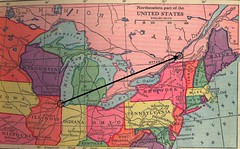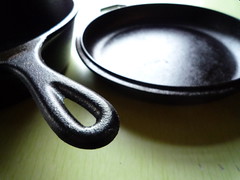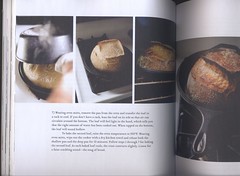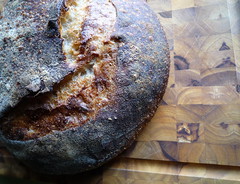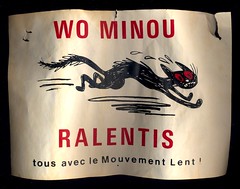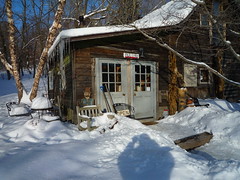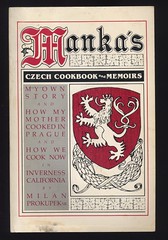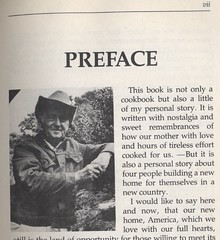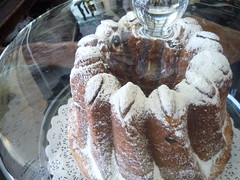 fig. a: kugelhopf 1
fig. a: kugelhopf 1
It's been two days since the Kaffeeklatsch event at Laloux and we're still buzzing. We had a good feeling going into this--there seemed to be a lot of enthusiasm in the air leading up to Sunday. And with fresh snow on the ground, a bright sun in the sky, mild temperatures, and a star-studded lineup of Central European pastries ready to go, it really seemed like everything was falling into place. The Linzer cookies were finalized. The strudel dough was stretched, brushed with butter, gently folded over apples, rum-soaked raisins, and walnuts, and baked. Cookies and cakes were placed on display. Team Myriade fine-tuned their equipment and prepped their coffees. Team Laloux readied themselves for service. And by 1:45 (!), people started to show up--in numbers (!!). What was billed as a 2:00 - 5:00 affair turned into a 1:45 - 5:45 affair, but, more importantly, the atmosphere was positively electric. No one spontaneously burst into poetry the way Michelle had imagined, but she was treated to an impromptu poetry reading as she made the rounds (and she received another poem via email), and everywhere you looked people were klatsching it up and partaking in kaffee und kuchen as if they'd been doing it their entire lives.
 fig. b: kugelhopf 2
fig. b: kugelhopf 2
I was maybe not the most objective observer, but the combination of Michelle's cookies and pastries + Team Myriade's amazing brews + the charm and ambiance of Laloux's dining room on a bright winter's day was something to behold. And a lot of people I talked to seemed to feel similarly.
If you couldn't make it out on Sunday and you're having a hard time imagining what Kaffeeklatsch looked like, this should give you an idea:
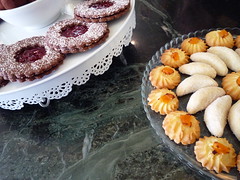 fig. c: petit fours*
fig. c: petit fours*
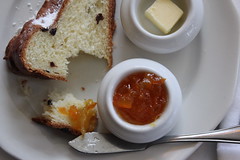 fig. d: kugelhopf plate**
fig. d: kugelhopf plate**
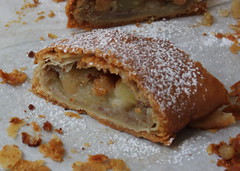 fig. e: strudel**
fig. e: strudel**
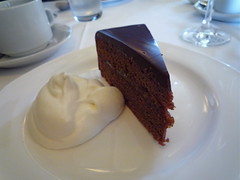 fig. f: sachertorte mit schlag
fig. f: sachertorte mit schlag
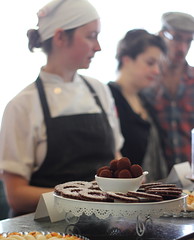 fig. g: Michelle & co.**
fig. g: Michelle & co.**
And even if you did get a chance to attend, you might be curious to see what was going on behind the scenes. If you've never made a strudel, this is what the process looks like as the dough is stretched to the point of translucency, stuffed with the apple/raisin/nut filling, and folded.
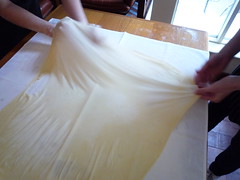
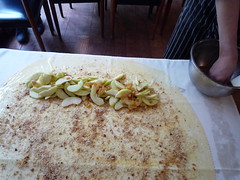
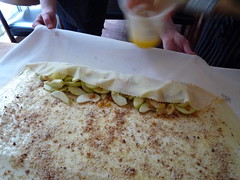 figs. h, i, j: strudel 101
figs. h, i, j: strudel 101
If all this sounds/looks like fun and you weren't able to make it, I can say with some degree of certainty that there will be repeat performances of Kaffeeklatsch in the future. We had too much fun for it to be otherwise--it would be a shame not to throw another one. Plus, we've got all kinds of ideas for future ones: readings, live music, films, etc. So stay tuned to "...an endless banquet" for news of future Kaffeeklatsch events (or, if you can prefer, you can join our new Kaffeeklatsch Mtl page on Facebook). We just need to figure out a schedule (monthly? bi-monthly? quarterly?).
I can also say that if you're interested in trying Michelle's sachertorte, she'll be offering this chocolate-apricot delicacy as the dessert du jour at Laloux all this week.
Lastly, thanks to Laloux for hosting, Team Myriade for kicking out the jams, and extra-special thanks to all of you who graced Kaffeeklatsch #1 with your presence and made the event a smash hit.
aj
P.S. After all that coffee, after all the excitement, after listening to DJ Der Kommisar's Kaffeeklatsch Klub Mix for hours on end, we were jonesing for a classic Central European meal of some kind. Thing is, we were also exhausted, so when we got an invitation to a Super Bowl tacos night with some friends, we jumped at the opportunity, and it was just what the doctor ordered: overstuffed tacos, ice-cold beers, chips, football, Glee, and good times.
The next day that hankering hadn't subsided, though, and we still had a few pieces of Michelle's kugelhopf left over, so we did the only sensible thing: we baked some sourdough rye, whipped up some goulash, and invited some people over for a collaborative Hungarian feast, complete with cucumber salad, körözött júhtúró (an enchantingly umami-rich cheese spread), Hungarian freak-folk (Félix Lajkó!), Hungarian folk-metal (Vágtázó Halottkémek!), some simultaneous translation, and a trio of impressive Hungarian wines: a dry 2007 Tokaji Furmint, a 2007 Hunyadi Kéthely, made with the pinot noir-like kékfrankos (blaufrankish) grape, and 1996 Tokaji Aszú 5 Puttonyos dessert wine.
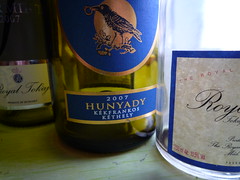 fig. k: après le déluge
fig. k: après le déluge
Want to make your own goulash? You can find our AEB recipe here.
Curious about that cheese spread? Here's a recipe:
Körözött Júhtúró, a.k.a. Liptó Cheese Spread
1/2 pound Liptó sheep's milk cheese [this cheese is known as Liptauer in Austria, and Romanian/Slovak Brindza is an acceptable substitute--in Montreal, you can find it at select Central- and Eastern-Europe specialty food stores, like Slovenia (6424, rue Clark)]
1/4 pound lightly salted butter, softened
1 tsp Hungarian paprika [you can use either sweet or hot paprika--we opted for hot]
1/2 tsp prepared mustard [think Central European/German mustard]
1/2 tsp pounded caraway seeds
1 small onion, grated
1/2 tsp anchovy paste [we made our own using salt-packed anchovies]
garnishes: radish slices, green chiles, scallions
Sieve the cheese and mix it with softened butter and all other ingredients until the spread is light red in color and evenly mixed. Refrigerate.
Serve with slices of good, crusty bread, such as freshly baked sourdough rye, accompanied with garnishes.
Mystified by the anchovies? I was. Especially when our friend A. described this dish as something you might get served in the Hungarian countryside. When I asked him about the anchovies he had one word in reply: "Trieste." Of course.
Never tried a Hungarian wine? You can find all three of the wines mentioned above at the SAQ.
* l-r: rum balls, Linzer cookies, vanilla spritz cookies,
hazelnut crescents
** very special thanks to EM for the additional photographs
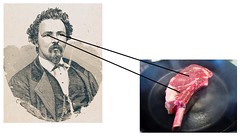 fig. a: good god!
fig. a: good god!